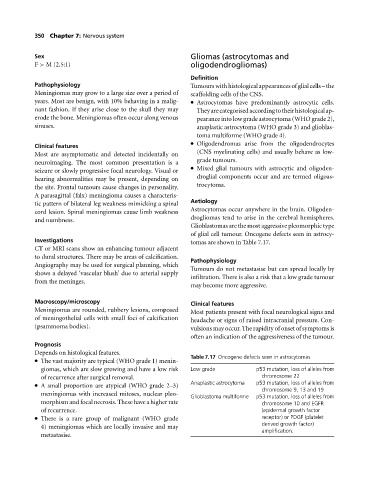Page 354 - Medicine and Surgery
P. 354
P1: FAW
BLUK007-07 BLUK007-Kendall May 25, 2005 18:18 Char Count= 0
350 Chapter 7: Nervous system
Sex Gliomas (astrocytomas and
F > M (2.5:1) oligodendrogliomas)
Definition
Pathophysiology Tumours with histological appearances of glial cells – the
Meningiomas may grow to a large size over a period of scaffolding cells of the CNS.
years. Most are benign, with 10% behaving in a malig- Astrocytomas have predominantly astrocytic cells.
nant fashion. If they arise close to the skull they may Theyarecategorisedaccordingtotheirhistologicalap-
erode the bone. Meningiomas often occur along venous pearance into low grade astrocytoma (WHO grade 2),
sinuses. anaplastic astrocytoma (WHO grade 3) and glioblas-
toma multiforme (WHO grade 4).
Oligodendromas arise from the oligodendrocytes
Clinical features
Most are asymptomatic and detected incidentally on (CNS myelinating cells) and usually behave as low-
neuroimaging. The most common presentation is a grade tumours.
Mixedglial tumours with astrocytic and oligoden-
seizure or slowly progressive focal neurology. Visual or
droglial components occur and are termed oligoas-
hearing abnormalities may be present, depending on
trocytoma.
the site. Frontal tumours cause changes in personality.
A parasagittal (falx) meningioma causes a characteris-
Aetiology
tic pattern of bilateral leg weakness mimicking a spinal
Astrocytomas occur anywhere in the brain. Oligoden-
cord lesion. Spinal meningiomas cause limb weakness
drogliomas tend to arise in the cerebral hemispheres.
and numbness.
Glioblastomas are the most aggressive pleomorphic type
of glial cell tumour. Oncogene defects seen in astrocy-
Investigations tomas are shown in Table 7.17.
CT or MRI scans show an enhancing tumour adjacent
to dural structures. There may be areas of calcification.
Pathophysiology
Angiography may be used for surgical planning, which
Tumours do not metastasise but can spread locally by
shows a delayed ‘vascular blush’ due to arterial supply
infiltration. There is also a risk that a low grade tumour
from the meninges.
may become more aggressive.
Macroscopy/microscopy Clinical features
Meningiomas are rounded, rubbery lesions, composed Most patients present with focal neurological signs and
of meningothelial cells with small foci of calcification headache or signs of raised intracranial pressure. Con-
(psammoma bodies). vulsions may occur. The rapidity of onset of symptoms is
often an indication of the aggressiveness of the tumour.
Prognosis
Depends on histological features.
Table 7.17 Oncogene defects seen in astrocytomas
The vast majority are typical (WHO grade 1) menin-
giomas, which are slow growing and have a low risk Low grade p53 mutation, loss of alleles from
of recurrence after surgical removal. chromosome 22
A small proportion are atypical (WHO grade 2–3)
Anaplastic astrocytoma p53 mutation, loss of alleles from
chromosome 9, 13 and 19
meningiomas with increased mitoses, nuclear pleo- Glioblastoma multiforme p53 mutation, loss of alleles from
morphism and focal necrosis. These have a higher rate chromosome 10 and EGFR
of recurrence. (epidermal growth factor
There is a rare group of malignant (WHO grade
receptor) or PDGF (platelet
derived growth factor)
4) meningiomas which are locally invasive and may
amplification.
metastasise.

